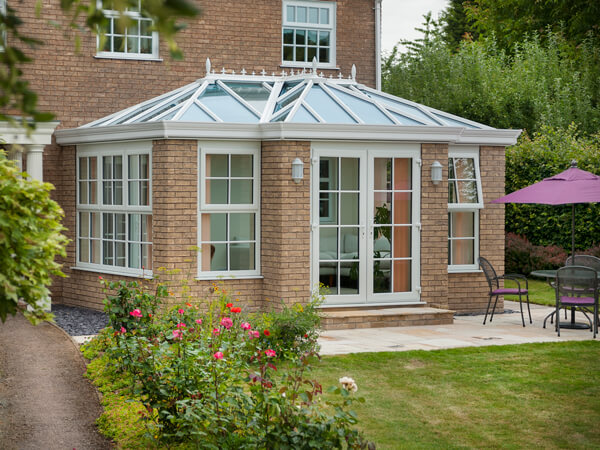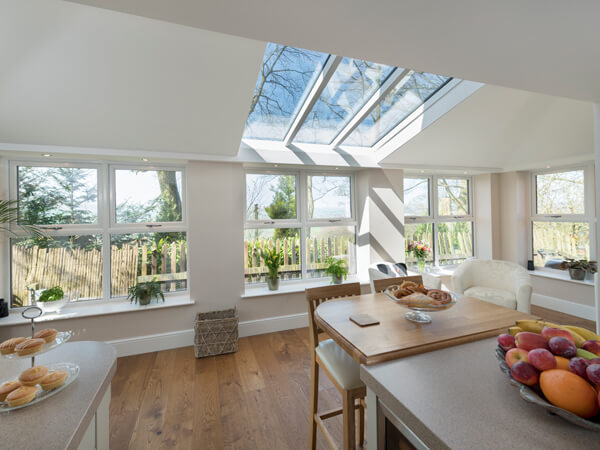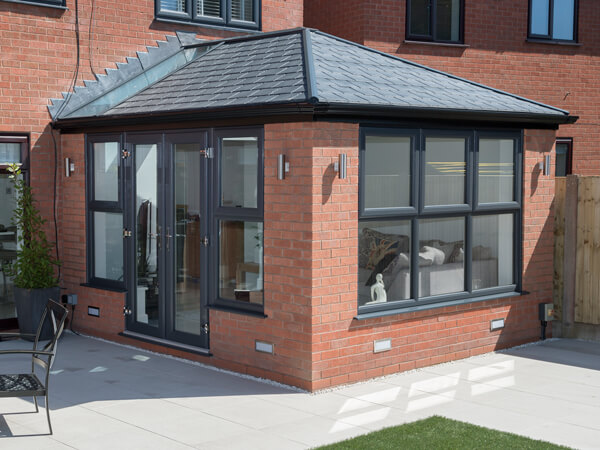What's the difference between a conservatory, orangery and an extension?
The million dollar question! The truth is, the lines have become blurred in recent years and quite simply, your living space can be whatever you want it to be. Traditionally, you would consider a conservatory to be mainly glass – glass roof, glass walls, and afford a stunning view of your garden and the sky. These days however, you can also have a tiled roof conservatory for added warmth and comfort, and dwarf walls for added insulation. There are also a huge variety of options for solar control glazing to ensure your room doesn’t get too hot or cold through the seasons.
An orangery generally incorporates brick or aluminium pillars for a little extra privacy and warmth -lending itself to a more luxurious feel. Orangeries also tend to feature a pelmet around the roof of the structure which again adds a little more thermal insulation to your room. Anything goes when it comes to roof style! Opt for a glass lantern, solid tiled roof or anything in between!

Home extensions tend to be designed to look and feel more like a natural extension of your home. Many incorporate more of a solid feel with more brickwork – and often (but not always) will feature a solid tiled roof of some kind. These days though, roofs can be truly hybrid, incorporating full length glass panels and/or Velux windows for added light and ventilation. Generally, extensions are chosen for their year-round useability, keeping them comfortably warm whatever the weather outside.
But who needs labels anyway! Speak to a Pennine advisor and we’ll be only too happy to create something unique to you.

Should I choose a tiled roof or a glass roof?
This totally depends on how you plan to use your room, which direction it faces, and your budget. If its plenty of natural light and a lovely view of the garden, then fear not – solar control glazing has come on in leaps and bounds in recent years and there are plenty of glazing options that can keep your room at a comfortable temperature.
For a truly year-round extension feel, a solid tiled roof is a strong contender – especially when you consider adding full length glass panels or Velux windows – a real hybrid between solid and glass roof with a combination of benefits from both options.
Speak to a Pennine advisor about the best option for you that meets your requirements and your budget.

MORE COMMON QUESTIONS
Our friendly advisors are always happy to answer any questions you may have. You will find answers to some of the most common questions they receive below.
Will it be too hot in summer and too cool in winter?
All of our living space products are designed with year-round comfort in mind. Gone are the days of the old polycarbonate roof which makes for a make-shift green house for the majority of the year! Solar control glazing gives you some great options that can make a real difference, but if you’re really concerned about achieving a year-round extension, then a tiled roof will probably be the best option for you.
Do you manufacture your own roofs?
Yes, Pennine is part of the Conservatory Outlet Group of companies, and its sister company Conservatory Outlet is one of the leading manufacturers of roof products in the UK. All of our roofs are manufactured in the UK at Conservatory Outlet’s state-of-the-art manufacturing facility in Wakefield, West Yorkshire.
Having such a close relationship with our manufacturer means we retain close control over our supply chain – ensuring the exceptional, quality of our innovative product range is maintained at all times.
Can I choose different roof tiles to match my home?
Yes, absolutely. We have a range of shingle and slate roof tyle options for you to choose from. We can even match the roof tiles on your existing property if you require. We also have a number of flat roof membranes available. Speak to a Pennine advisor for further details.
I hear a lot about energy rated windows! What does 'A' rated windows mean?
A rated windows are the most energy efficient windows available in the UK as defined by the BFRC Rating Scheme. This is the UK’s national system for rating the energy efficiency of windows and is recognised within the Building Regulations as a method to show compliance for your replacement windows installation.
Window Energy Ratings use a consumer-friendly traffic-light style A-E ratings guide similar to that used on ‘white’ goods (such as fridges, freezers, washing machines etc…).
This ratings label can be used by you to make more informed choices about the energy efficiency of the windows you are looking to purchase.
What is solar control glazing?
Solar control glazing incorporates a clever coating on the glass that prevents excessive heat from being transmitted into your room, whilst also stopping your internal heat from escaping. We have a number of different tinted options which will give you varying degrees of light transmission and heat retention depending on your needs. Speak to a Pennine advisor for further detail.
Can I match to my existing bricks?
Our Pennine team will obtain the closest brick match to your existing property and check this with you before any works commence. Please do bear in mind that there may be weathering and manufacturing differences between existing and new bricks. If the closest match isn’t what you want, you do have the option to have your new brickwork tinted, but be aware that this will incur additional cost.
Do I need Building Regulations Approval?
Most extensions of properties require approval under Building Regulations. There are a number of classes of extensions that don’t – but fear not. Pennine will send a surveyor experienced in planning and building regulations to advise you of the options and requirements needed for your extension. Pennine will also arrange Building Regulations for you by approaching the relevant local authority.
Do I need planning permission?
An extension or addition to your house is considered to be permitted development, not requiring an application for planning permission, subject to certain conditions are met, typically these are:
- The ground area covered by the extension and any other buildings within the boundary of the property, excluding the original house, is not more than half the total area of the property.
- Any part of the extension is not higher than the highest part of the roof of the existing house.
- The eaves of the extension are not higher than the eaves of the existing house.
- Any part of the extension does not extend beyond any wall facing a road if it forms the principal or side elevation of the original house.
- The eaves are no more than 3 metres in height if any part of the extension is within 2 metres of the property boundary.
- The materials used in exterior work, except in the case of a conservatory, are of similar appearance to the existing house.
- An upper floor window on a side elevation within 15 metres of a boundary with another house is obscure glazed; and is non – opening unless the parts which can be opened are more than 1.7 metres above the floor of the room in which the window is installed.
- A side extension does not exceed 4 metres in height or be wider than half the width of the original house.
- In a single storey extension
- the extension does not extend beyond the rear wall of the original house by more than 4 metres for a detached house or 3 metres for any other type of house;
- the height of the extension does not exceed 4 metres;
- no part of the extension is within 3.5 metres of any property boundary with a road opposite the rear wall of the house.
- In an extension with more than one storey
- the extension does not extend beyond the rear wall of the original house by more than 3 metres;
- no part of the extension is within 7 metres of the property boundary opposite the rear wall of the house;
- the roof pitch of the enlargement is as far as practicable the same as that of the original house.
- If you live in a house within a conservation area, World Heritage Site, area of outstanding natural beauty or National Park-
- no part of the exterior of the house is clad with stone, artificial stone, pebbledash, render, timber, plastic or tiles;
- the extension is not more than 1 storey or 4 metres in height;
- no part of the extension extends beyond a principal or side elevation of the original house
How long will it take to build my new living space?
It is really difficult to estimate how long a particular build will take, dependent on planning requirements, and the complexity of the project. Please ask a Pennine advisor or ask for a copy of our ‘What happens next’ guide for an indication of timeline.
What is a test dig?
The purpose of a test dig is to ascertain local ground conditions to ensure they are suitable for a traditional concrete base and foundation prior to starting your build. Where the ground is found to be suitable we will advise on an alternative foundation proposal such as a specialist pile foundation or concrete raft.
What is a cavity tray?
A cavity tray is a series of high level damp proof courses that bridge a wall cavity to direct moisture to the external face of a wall where the extension roof joins the house wall. Essentially, a cavity tray prevents moisture that penetrates the outer wall from appearing in your new extension.
Do you offer finance to help me pay for for my new living space?
Yes. To make life easy for you, Pennine can arrange a variety of affordable and convenient easy payment finance options (subject to application & status). Applying for finance is simple and we promise you a quick decision. Everything can be sorted out with you in the comfort of your home or at your local Pennine Showroom, so you can enjoy whatever you’ve set your heart on right away.
What do we need to do when our finance is approved?
If you’re arranging your own finance, you’ll need to call us as soon as you get the go ahead. If you’re taking up one of our offers, the company will tell us both directly, so there’s no need to call as we will get in touch with you.
What happens if finance is refused?
Finance companies can turn down people for lots of reasons, for example if you’ve moved several times over the past few years. In these circumstances, we always do our best to help and sometimes it’s worth trying another provider, especially if they know you.
I’ve applied for finance with Pennine. How long will approval take?
Sometimes our finance company will say ‘yes’ almost immediately and on other occasions it may take them a few days. This short delay can be for any number of reasons and you should not be unduly concerned.
NEED MORE ANSWERS?
Simply fill in your details below and one of our customer advisors will get in touch to answer any of your questions.
